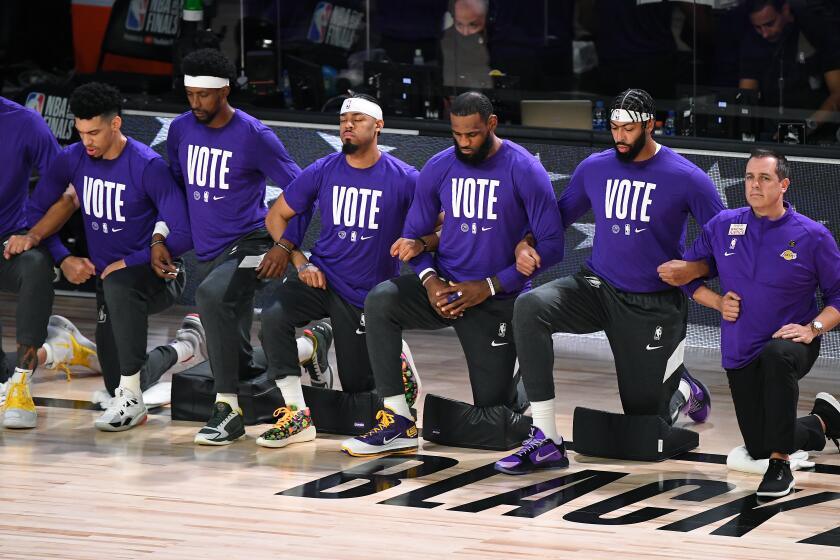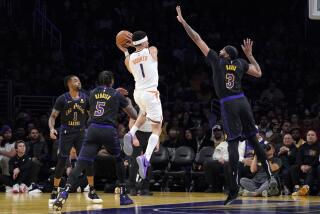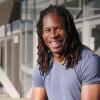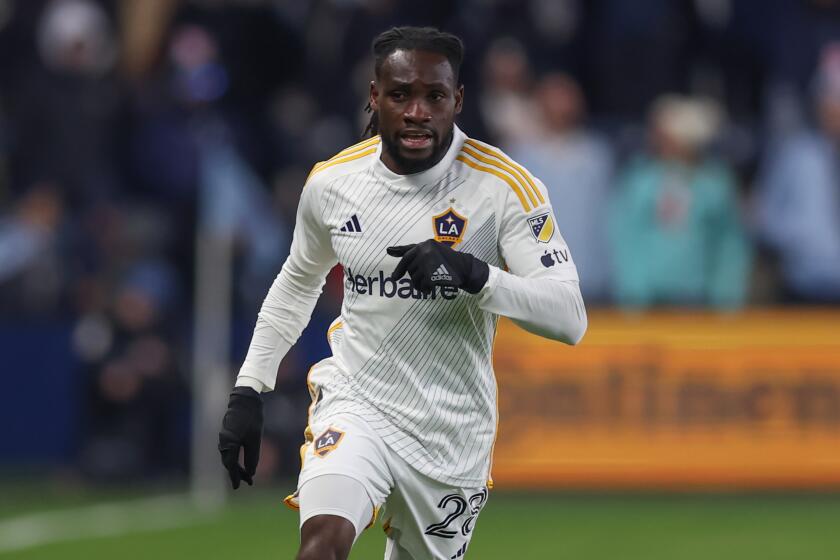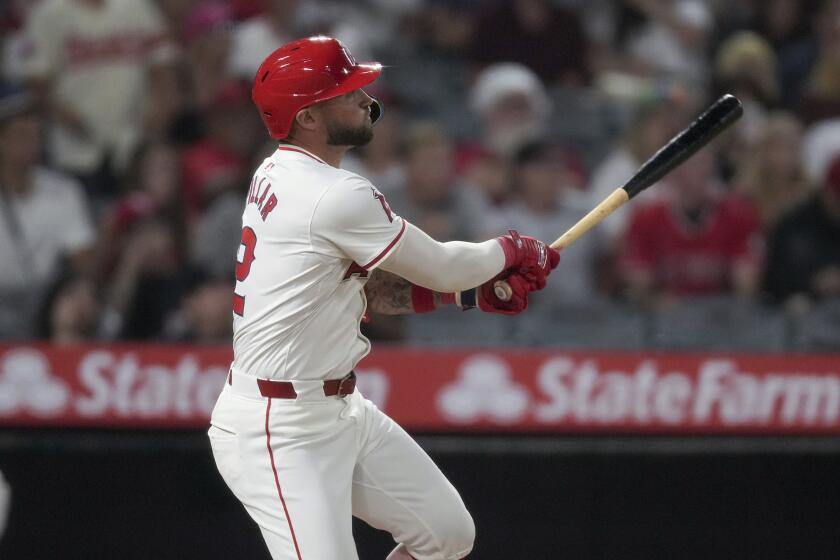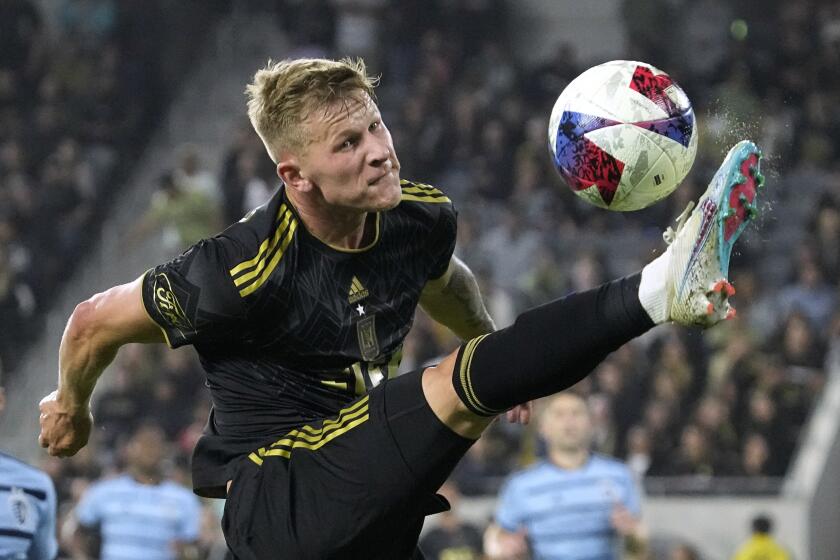Column: Lakers’ voting push extends beyond Staples Center and the 2020 election
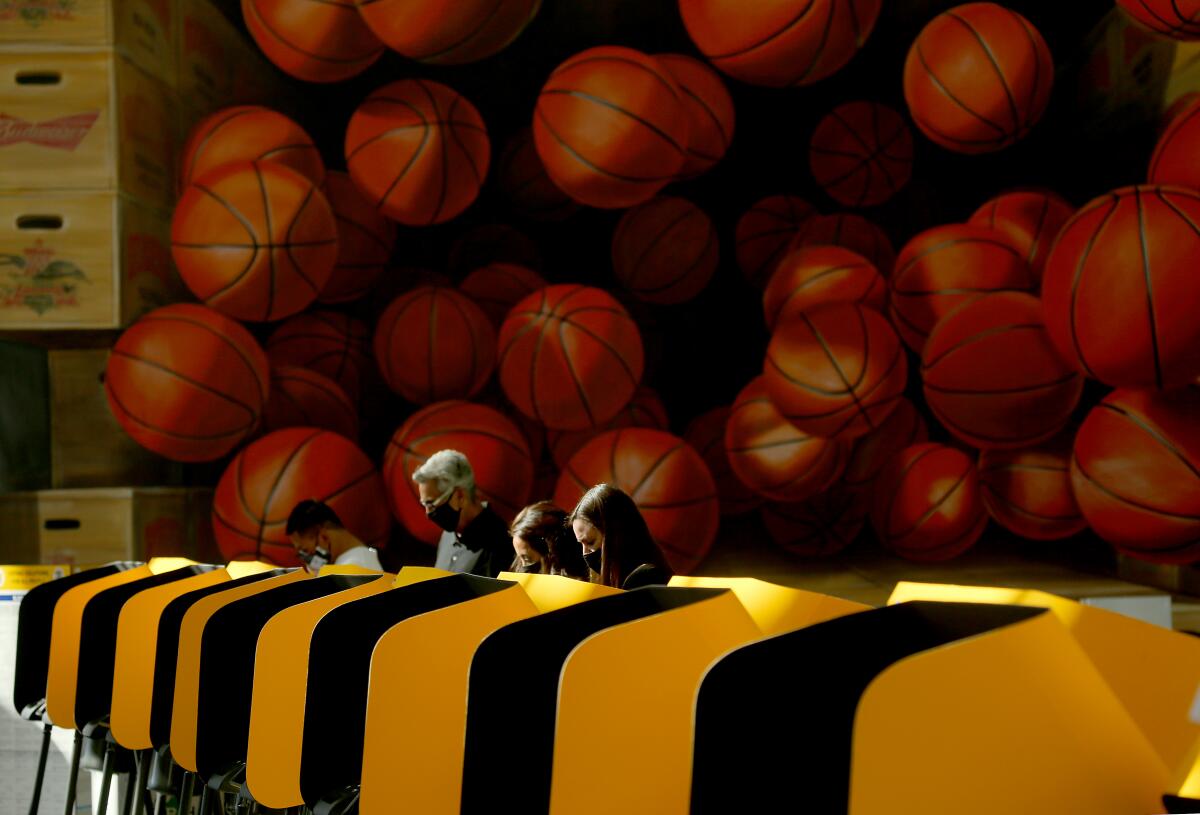
Devel Thompson walked into Crenshaw High’s gymnasium dressed for an occasion he didn’t even know was occurring. Decked out from head to toe in Lakers gear, Thompson said he had no idea the champs were involved in organizing the polling location there.
“This is just what I decided to wear today because we won the title,” he said. “It’s so cool to see us winning it all and now out here making sure people vote. I was going to drop [my ballot] off at the mailbox by the library but my mom told me to come here to drop it off.
“It feels so good to know the Lakers are doing this. They really looking out.”
The franchise is looking out because it first looked in.
“After George Floyd, our staff came to us and asked, ‘What can we do?’ And that started the journey for us,” said Tim Harris, the Lakers’ chief operating officer. “We were committed that whatever we decided to do would not be window dressing. So we talked a lot, realizing before we can act we have to first learn.”
In June, the Lakers hired Dr. Karida Brown, an assistant professor of African American Studies and Sociology at UCLA, as the team’s inaugural director of racial equity and action.
“I agreed to do it as long as I wasn’t there just for show,” said Brown, who began her tenure with a series of in-house workshops with some of the brightest researchers on the subject of race in America. “Once I realized they were committed to making systemic changes, I was on board.
“The franchise wanted to do what was within its wheelhouse. Many of us have a bleeding heart, so when you see the world is on fire we want to jump in and fix everything right away. However, it took over 400 years to build this system and no one person or organization is going to be able to dismantle that single-[handedly]. You have to identify the things you can address, and that’s what we’re trying to do.”

It was a cross-generational scene at Crenshaw High Monday, with graduates going back as far as the class of 1970 showing up as well as teenagers getting involved politically for the first time. Young people like Maimouna Camara, 18, who said she volunteered as a poll worker because it was recommended by her government teacher.
“We’re all big Lakers fans, so when my family found out that I was working at one of the Lakers’ polling locations, they acted like we won the championship all over again,” Camara said.
Crenshaw High is not the only location the Lakers are involved with. Salesian High in Boyle Heights as well as Staples Center are also purple and gold voting locations.
“You need water to help the soil that helps the trees which helps the air and so on. The Lakers can’t solve the world’s problems but we can contribute positively to the ecosystem.”
— Karida Brown, the Lakers’ director of racial equity and action
“This is historic for the Lakers, for the NBA, for sports period,” said Kiesha Nix, executive director of the Lakers Youth Foundation. “It’s the first time we’ve been actively involved in hosting and sponsoring voting centers.
“The turning point for us is listening to our players. Not that we hadn’t listened to them before, but with all of the events that have gone on … they said, ‘Hey, what we’re doing is not enough we have to do more.’ It was really important for senior management and ownership to really hear and take their ideas and put them into action.”
With more than 34 million early voters deciding to do so in-person, it’s apropos that Staples Center would be one of the locations to open its doors in what is turning out to be one of the most unusual general elections in recent memory. Staples was where many protestors would gather before marching downtown, drawing attention to the deaths of Floyd, Breonna Taylor and Ahmaud Arbery. Near Staples is where the National Guard was stationed when some of the protests opened the door to rioting and burglaries. Now Staples is one of 20 NBA affiliated arenas being used as a polling location.
“The Lakers are one of the biggest influencers in L.A., and for them to get behind this is a huge push for people to get out there,” said Ted Kim, who owns Seoul Sausage with his brother Yong Kim. Seoul Sausage has been providing free food to voters standing in line at Staples. “We saw so many people wearing their Lakers and Dodgers jerseys to go vote, and it was super cool to see businesses people respect get behind the election.”

“Movements are always at risk of fizzling out because it’s exhausting to keep a conversation going, especially about something that is as heavy as anti-racism. What [LeBron James] and other professional athletes have done is breathed life into the movement, saying, ‘No, we ain’t done.’”
— Karida Brown, the Lakers’ director of racial equity and action
Sherrie Deans, executive director of the NBA Players Assn. Foundation, said the movement was never about just this one election. “The election was an important part of the civic process, an important part of changing our reality as Americans, as Black Americans, and for them as predominantly Black men in America,” she said. “That includes who is making the decisions, who feels the pressure to support and change communities that our players care about.
“So I don’t think anyone who was [in the league’s Orlando, Fla., bubble] advocating for people to get out and vote thought of it as just a singular engagement moment, but as a necessary part of their process.”
Harris said this is a permanent part of the Lakers’ DNA.
“When our staff asked what can we do, they weren’t asking about just this year,” he said. “They meant what can we do as an organization to address a systemic problem … so we took our time to come up with a systemic solution.”
The Lakers’ action plan is comprised of six basic parts: increase usage of minority-owned vendors; continuing education on diversity and inclusion for leadership; pay equity and promotion audits; grants; a Lakers library; and an arts project that will showcase the work of established area minorities selected by the players and displayed at the training facility. Those pieces will then be auctioned with funds going to up-and-coming artists who will contribute pieces to be auctioned later, making the endeavor self-sustaining.
“All of the pillars of the action plan are multiyear projects,” Brown said. “We want to have sustained action … because there isn’t a silver bullet to this. It’s an ecosystem.”
Big-name athletes are more likely to talk politics and social justice in the locker room now than at any other time.
Although the Lakers have a history of philanthropy and working for social justice, Brown said having an active and vocal LeBron James on the squad was a shot in the arm.
“I’m so proud of the work many sports teams across the country are doing to get people to vote,” she said. “Movements are always at risk of fizzling out because it’s exhausting to keep a conversation going, especially about something that is as heavy as antiracism. What [James] and other professional athletes have done is breathed life into the movement, saying ‘No, we ain’t done.’ ”
Which is something Kristen Clarke, president of the Lawyers’ Committee for Civil Rights Under Law, said is not new.
“Black athletes have always been voices for justice,” said Clarke, whose organization is the sole benefactor of More Than a Vote, a bipartisan coalition of Black athletes and artists who are concerned about voter suppression. For example, state legislators in Florida passed a law requiring ex-felons to pay all fines before being eligible to vote, which harkens back to the poll taxes of the Jim Crow era. More Than a Vote is working to change the law and paid the fines so those individuals can vote.
Identifying gaps in the democratic process was something the Lakers were particularly passionate about. Brown said the locations for the early-voting polling places targeted “historically Black and Latino concentrated neighborhoods because we know those areas are often underserved when it comes to polling places.
“With the pandemic,” she added, “it is even more important that there are more places for folks to vote and spacious places where voters can adhere to social distance practices and not put themselves further at risk just to exercise their civic duty.”
Making polling places available is particularly important for Black voters, Brown said, because it’s tradition to stand in line and cast a ballot in-person, paying homage to ancestors who shed blood, fighting for the right to vote.
My 74-year-old mother got dressed up in heels and full makeup to vote early last week. I donned my T-shirt bearing the late Rep. John Lewis’ face after getting my locs tightened for the occasion. I witnessed a consistent stream of voters, many dressed in either Lakers gear or Sunday-go-to-meeting clothes, making their way to Staples to vote, take pictures, and then walk down to a nearby restaurant for fellowship.
The scene was very much like the one outside of Staples after a Lakers win, only this time, the show of solidarity commemorated a different kind of victory. For when it feels as if the powers that be are trying to quiet your voice, knowing that you can still be heard is a win like no other.
Watch L.A. Times Today at 7 p.m. on Spectrum News 1 on Channel 1 or live stream on the Spectrum News App. Palos Verdes Peninsula and Orange County viewers can watch on Cox Systems on channel 99.
More to Read
Get our high school sports newsletter
Prep Rally is devoted to the SoCal high school sports experience, bringing you scores, stories and a behind-the-scenes look at what makes prep sports so popular.
You may occasionally receive promotional content from the Los Angeles Times.
